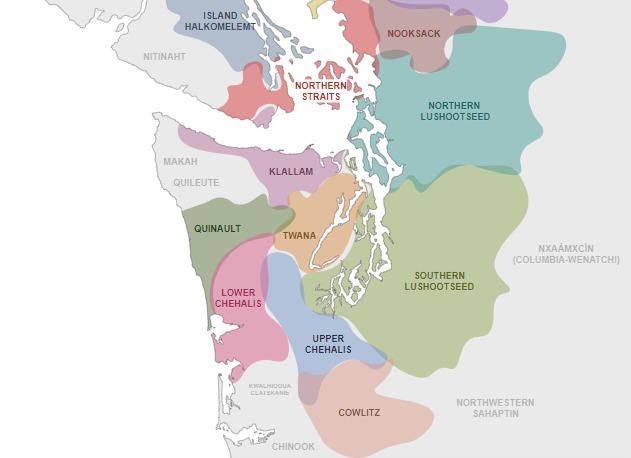Hahobas History - The Twana Peoples
The Twana Peoples - How Camp Hahobas Got Its Name
Home > Hahobas History > The Twana PeoplesCamp Hahobas is located on the portion of the eastern side of Hood Canal that falls within the ethnographic territory of the Twana peoples, now largely part of the Skokomish Indian Tribe.
The Hahobas scout camp at Robbins Lake is located just inland from and between two Twana camps formerly located on the Hood Canal shoreline, one, hoho'bas , near Red Bluff, from which the Twana collected red ochre, and bəsaXa·dač, near Little Dewatto Bay (Elmendorf 1992: 52). The name of the Scout camp is derived from the former.
In the 1960's, the Hahobas Scout Reservation was divided into two camps; Camp Tahoma and Camp Twana, names also derived from the local peoples.
Twana traditional lifeways were, like those of other Coast Salish peoples, based on management of marine and terrestrial resources including salmon, marine mammals, shellfish, waterfowl, deer and elk, roots, berries, and culinary and medicinal plants. Winters were spent in cedar plank houses shared by large extended families, with more casual residential structures and camps used during the warmer months.
A network of trading and familial relationships with other Salish peoples connected the Twana with the rest of the Puget Sound region. Those relationships were reinforced at the Twana’s massive potlatch houses, some hundreds of feet long, built along the shoreline away from residential areas, where people gathered for community and religious events. Slaves, houses, and canoes were considered an individual or family’s personal property, and fish weirs were generally owned by the household that built them, but land was thought of as the collective responsibility of the people (Bouchard and Kennedy 1994; Elmendorf 1992: 258-9, 268).
The area which is now the scout camp was logged before the 1930s, and the camp parcels were purchased from Mason County for negligible payments in the 1930s and 1940s. The parcels have been in active use by the local Scout Council as a Boy Scout camp from that time onwards. The scouts have built a great variety of camp amenities at the property during this period, including docks, shelters, storage sheds, an outdoor theater, shooting ranges, and covered skills instruction areas, some of which remain.
Thousands of scouts passed through the camp over the years and the property retains considerable regional sentimental importance. Most of the Scout reservation was recently transferred to a governmental agency, which plans to manage it as state trust forestlands.
Compiled by Sara Palmer, Scoutmaster, Troop 007, Lacey, WA
State Lands Archeologist
Bibliography:
Bouchard, Randy and Dorothy Kennedy
1994 Twana Indian Knowledge and Use of the Cushman Project Area. B.C. Indian Language Project, Victoria, British Columbia, Canada. Prepared for Tacoma Public Utilities, Tacoma, Washington. On file at the Washington State Department of Archaeology and Historic Preservation, Olympia.
Elmendorf, William W. and A. L. Kroeber
1992 The Structure of Twana Culture, With Comparative Notes on the Structure of Yurok Culture. Washington State University Press, Pullman, Washington.
















